Our Lake Management Program: What the FPC Is Doing About Invasive Weeds in the Pond, and What You Can Do To Help
On this page you'll find an overview of the Foster's Pond Corporation's four-part integrated management program to control nuisance vegetation. And you'll also find detailed advice on what can I do to keep weeds from flourishing in the Pond.
For detailed current and historical information on what's happening now and what we've done through the years, you can click on the following four links; for a broader overview of our programs, and what you can do, stay on this page.
Weed Updates A blog of our lake management activities, spanning more than a decade. Includes the latest news on treatments, closures, and observations, with loads of pictures, maps, and information.
What's in the Pond Studies of the Pond’s weed problems.
A Brief History of Weed-Whacking on the Pond A review of six decades of control efforts from the 1940s to 2004.
Hydro-Raking Information on hydro-raking, a mechanical program to remove muck and weeds from shoreline areas.
Keep 'Em Outta Here: Stop Aquatic Hitchhikers
Don't feed the algae!
Pond-friendly fertilizers
Zero-phosphate detergents for dishes and laundry
High marks for 3 "green" dishwashing powders!
Begone, Goose! How to discourage these elegant polluters
What's the Corporation doing about weeds?
An Overview: Our Four-Point Management Program
Herbicide Use
Winter drawdowns
Hydroraking
Nutrient Management
An Overview: Our Integrated Management Program
The Foster's Pond Corporation, beginning in 2004, adopted an "integrated management program" to deal with the problem of nuisance weeds. There are four basic components of the program:
(1) Herbicide use.
The Corporation in 2005 initiated the use of fluridone
(Sonar) for the control of our predominant weed, fanwort.
This non-native, invasive exotic
- probably introduced either through a visiting boat bringing a  fragment from another pond, or by an aquarium owner dumping a fish and
a plant fragment - had taken over Foster's Pond, covering over half
the open water. Fluridone is the least toxic aquatic herbicide
approved by the State, okayed for use even in drinking water
reservoirs. It is the only approved herbicide effective against
fanwort. The State's Department of Environmental Protection, in its Generic Environmental
Impact Report on aquatic plant management (page 4-89), suggests
that for the control of fanwort in Massachusetts, "chemicals for
management are a necessity until some other more long-term control,
such as plant-eating insects, can be established."
fragment from another pond, or by an aquarium owner dumping a fish and
a plant fragment - had taken over Foster's Pond, covering over half
the open water. Fluridone is the least toxic aquatic herbicide
approved by the State, okayed for use even in drinking water
reservoirs. It is the only approved herbicide effective against
fanwort. The State's Department of Environmental Protection, in its Generic Environmental
Impact Report on aquatic plant management (page 4-89), suggests
that for the control of fanwort in Massachusetts, "chemicals for
management are a necessity until some other more long-term control,
such as plant-eating insects, can be established."
Even with Sonar, fanwort is almost impossible to eradicate. Sonar must be used every few years to control the inevitable re-emergence of fanwort. The FPC carefully monitors the health of the Pond, conducting systematic vegetation surveys every year or two to detect the presence of invasive weeds and the re-establishment of native plants. Small
re-infestations
can be fought with such techniques as hand-pulling, which can postpone
the need for reusing herbicides, but hand-pulling can do more harm than good, as fanwort is quite delicate and even small fragments can break off and root elsewhere in the Pond..
The Corporation has successfully treated the Pond for fanwort and other invasives, restoring a more balanced ecology in the Pond. To read detailed accounts of these weed control efforts, with pictures, links to the vegetation surveys, and maps, click here.
(2) Winter drawdowns. In 2005-06, the Corporation for the first time in nearly 30 years re-instituted annual winter drawdowns, lowering the level of the Pond 18 inches in late fall. Winter drawdowns are primarily a safety measure to accommodate spring snow melts and rains without overtopping the dam. In addition, drawdowns expose susceptible nuisance weeds like fanwort to freezing and drying, and flush suspended debris, sediments, and nutrients from the Pond.
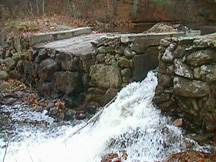 The mechanics of a winter drawdown are simple and inexpensive.
Three stop logs (also called "weir boards") are removed from the 3-foot wide
sluiceway located just to the right of the dam's much wider spillway. These horizontal boards, each
just 10" tall, are removed one at a time during the month of November,
allowing the Pond's level to fall slowly by a total of 18". When the
danger of overtopping subsides in late Spring, the stop logs are restored, one by one,
so that the Pond level is brought back to normal levels.
The mechanics of a winter drawdown are simple and inexpensive.
Three stop logs (also called "weir boards") are removed from the 3-foot wide
sluiceway located just to the right of the dam's much wider spillway. These horizontal boards, each
just 10" tall, are removed one at a time during the month of November,
allowing the Pond's level to fall slowly by a total of 18". When the
danger of overtopping subsides in late Spring, the stop logs are restored, one by one,
so that the Pond level is brought back to normal levels.
The Corporation, relying largely on neighborhood volunteers, has made massive efforts to restore and maintain the dam since the photo here was taken in 2005, increasing the spillway's capacity, buttressing the earthen core of the dam, re-engineering an emergency spillway (which doubles as an accessway for launching a canoe, kayak or bass boat. These efforts, combined with the winter drawdowns, have diminished the likelihood of overtopping.
Visit our dam blog for accounts of the improvements we've made, recent floods which threatened the dam, and the drawdowns we've implemented.
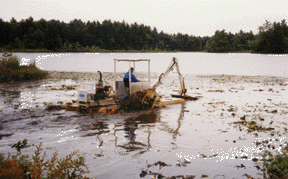 (3) Hydroraking.
Individual shorefront property owners have paid to have their
shorelines hydro-raked, every couple of years
or so, since 1992. The process removes lilies, debris, and
muck, but does not effectively control fanwort or other invasive weeds. By removing nutrient-rich sediments, hydro-raking plays a role in reducing algae in the Pond.
(3) Hydroraking.
Individual shorefront property owners have paid to have their
shorelines hydro-raked, every couple of years
or so, since 1992. The process removes lilies, debris, and
muck, but does not effectively control fanwort or other invasive weeds. By removing nutrient-rich sediments, hydro-raking plays a role in reducing algae in the Pond.
(4) Nutrient management. Controlling phosphorous inputs is an important part of controlling algae blooms in the Pond. Rooted plants like fanwort draw nutrients from bottom sediments, and thus are not controlled by reducing phosphorous contributions from detergents, septic systems, or run-off. But management of these nutrient inputs does improve overall water quality - and reducing them can have a huge effect on algae.
The Corporation took a big step forward in 2017, commissioning a Watershed-Based Plan to identify the amounts and likely sources of phosphorous flowing into the Pond each year from run-off throughout the watershed. The analysis indicated that there is no silver bullet - no single step that will eliminate the problem. But there is a lot we can do, together and as individuals, to reduce phosphorous in the Pond.
The Corporation will continue its efforts to educate Pond area residents, and the general public, on sound watershed management practices - like eliminating phosphate use in our watershed, and monitoring inlet streams. This web site is an important part of that effort.
What can I do about weeds?
Keep 'Em Outta Here: Stop Aquatic Hitchhikers
"Aquatic hitchhikers" are nuisance species - plants and animals - which can spread from one water body to another on the equipment or clothing of anglers and boaters.
Indeed, the chief villain in the Foster's Pond weed story - fanwort - is a non-native species easily spread from pond to pond on boots, boats, propellers,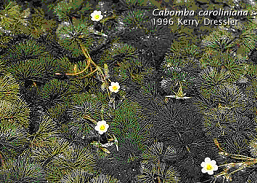 fishing gear, or even your dog. It, like many other nuisance weeds, propagates by fragmentation. Even small bits transported on gear or clothes can reproduce, spreading quickly to clog the water. Fanwort is a common aquarium plant, and one frequent method of introduction into a pond is the pet-owner who "liberates" an oversized denizen of his or her aquarium, along with that decorative sprig of fanwort - potentially giving rise to two problems.
fishing gear, or even your dog. It, like many other nuisance weeds, propagates by fragmentation. Even small bits transported on gear or clothes can reproduce, spreading quickly to clog the water. Fanwort is a common aquarium plant, and one frequent method of introduction into a pond is the pet-owner who "liberates" an oversized denizen of his or her aquarium, along with that decorative sprig of fanwort - potentially giving rise to two problems.
It is essential - particularly after we've spent thousands of dollars to eradicate the problem - to protect Foster's Pond from more fanwort (and a lot of other 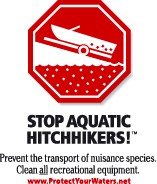 potential non-native invaders) which can hitchhike on the clothing, boats, and gear of visitors.
potential non-native invaders) which can hitchhike on the clothing, boats, and gear of visitors.
The Foster's Pond Corporation has teamed with the U.S. Fish and Wildlife Service as part of a nationwide campaign to Stop Aquatic Hitchhikers. It's a public awareness effort to provide information to aquatic recreation users about the simple procedures we can all follow to stop the spread of aquatic nuisances:
• Remove any visible mud, plants, fish or animals before transporting equipment
• Eliminate water from equipment before transporting
• Clean and dry anything that came in contact with water (boats, trailers, equipment, clothing, dogs, etc.)
• Never release plants, fish or animals into a body of water unless they came out of that body of water.
For more detail on these procedures, click here. Tell your guests about these procedures before they arrive with their kayak or fishing pole. Just e-mail this link:
http://www.fosterspond.org/aquatic_hitchhikers_procedures.pdf
Remember these procedures when you take your canoe to another water body (or bring it back).
Please don't feed the algae!
The Number 1 algae-control strategy is this: Don't fertilize them!
That means reducing - or eliminating - your use of phosphorous (in its most common household form, phosphates).
The concentration of nutrients must be reduced to slow the eutrophication (aging) of Foster's Pond. Phosphorous is the one nutrient within our power to control, due to its limited availability in the natural pond environment. If the input of phosphorous is controlled, the algae growth in the pond will also be controlled.
A large portion of the input of phosphorous to Fosters Pond is from us - that is, from our septic systems, lawn and garden fertilizers, and detergents. To control the input from septic systems, keep them in top working condition with regular pumping.
The use of fertilizers should be minimized. Better yet, don't use them at all! Follow the tips in the State's brochure, Lawns and Landscapes in Your Watershed. And be sure to shop for phosphate-free fertilizers.
Cleaner Dishes and a
Cleaner Pond:
Use a Zero-Phosphate Detergent in Your Dishwasher! "'Green' products can get dishes clean." That's the word from Consumer Reports, the independent rating bible for household products. The magazine rated twenty dishwasher detergents (including all of the major not-so-green brands), and rated Trader Joe's store brand #2. Also in the top tier was Seventh Generation powder (available at Whole Foods), followed by Ecover powder (available at Whole Foods). TJ's was the cheapest of the zero-phosphate detergents. And that was the lowest cost among the top five detergents tested. |
Above all, use phosphate-free detergents for laundry and dishes. This
represents the single most
important step each of us can take to
keep down
weeds in the Pond.
Consider the following:
Each household near the Pond may contribute ten pounds or more of
phosphorous just from detergents every year. This ten pounds can result
in 1 to 2 acres of heavy algae growth in the Pond.
The good news
is that laundry
detergents, which used to contribute two-thirds of the total
phosphorous from
detergents, are now almost all phosphate-free. So are most hand dishwashing detergents.
The bad news
is that most automatic dishwashing
detergents have phosphates in them - you need to look for a low-phosphate
or phosphate-free liquid or powder dishwasher detergent.
Phosphate-free dishwasher
detergents are available at Whole Foods, Trader Joe's and Stop&Shop - and
they work!
Powder dishwashing machine detergents
are the worst offenders. Cascade contains 6.4% phosphates, Market
Basket AutoDish 5.3%, Electrasol 4.5%, and Sunlight 4.5%. Not
good.
Liquid dishwashing machine detergents are,
as a group, slightly better. Cascade contains 4.5% phosphates,
Electrasol 4.5%, Sunlight 4.3%, Market Basket Gel 4.0%, and (best of
the lot) Palmolive 1.6%.
But 0.0% is best of all - so go to a natural products vendor and get a phosphate-free dishwashing machine detergent.
Begone, Goose!
Geese -
especially in large numbers - are not good for the Pond. They  deposit between one
and two pounds of bacteria-laden, nutrient-rich
waste into the water each and every day, polluting the Pond and
contributing to algae growth.
deposit between one
and two pounds of bacteria-laden, nutrient-rich
waste into the water each and every day, polluting the Pond and
contributing to algae growth.
They became particularly numerous in yards along Azalea Drive, where
residents reported encountering dozens of them spending several hours a
day in front yards up and down the block. And they are also a nuisance on a few shorefront lawns in the Channel area and the Main Pond.
For shoreline properties, there are humane ways of encouraging them to forage (and defecate) elsewhere. The Lakes and Ponds Program of the State's Department of Conservation and Recreation has experimented with the use of inexpensive, low-tech barriers to discourage geese from intruding on shorelines and beachfront areas - and they work.
Lawn Carp?An editorial a few years ago in the Boston Globe says that's the moniker that non-migratory local geese have earned for themselves. These "winged slackers," says the Globe, "have taken on a verminous quality," adding, "People should feel no hesitation about any humane method to limit their numbers."To read the full editorial, click here. |
As explained by DCR staff, geese are very particular. Since geese can't spot a predator in tall grass, they won't wade ashore where they have to pass through chest-high vegetation. And they like to conserve energy. Since they need a running start to take off, and they can't hop over even short barriers, even a low barrier is enough to keep adults off a particular shoreline. And goslings don't develop flight feathers until later in the summer, so low fences keep them out, too. All it takes to guard a shoreline, according to DCR staff , is any of the following: two parallel ropes, strung tight at heights of 6" and 1', at the shoreline; an 18" rabbit fence; or a shoreside row of natural plantings (weeds or grasses will do the trick) that are chest-high to a goose.
Foster's Pond
Road resident Janet Kenney reports success with a 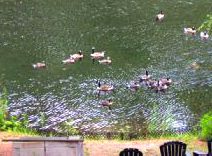 ready-made fence
(barely visible, at the water's edge, in this picture of her shoreline,
with frustrated geese about to swim away). Janet writes,
"The fence consists of plastic (snap-together) sections 12 inches high
with 2-inch stakes attached. The lattice design works! I
purchased the sections (3 packages) for under $25 at Lowe's. Best
investment I ever made - well worth it! I also let the weeds grow high."
ready-made fence
(barely visible, at the water's edge, in this picture of her shoreline,
with frustrated geese about to swim away). Janet writes,
"The fence consists of plastic (snap-together) sections 12 inches high
with 2-inch stakes attached. The lattice design works! I
purchased the sections (3 packages) for under $25 at Lowe's. Best
investment I ever made - well worth it! I also let the weeds grow high."
To read the
State's take on the Canada goose problem - a two-page leaflet with some
advice on "preventing goose grief" - click here.


 Questions? Comments? Contact us at
Questions? Comments? Contact us at